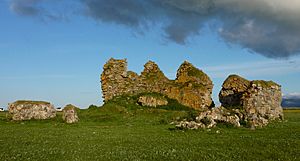Borve Castle, Benbecula facts for kids
Borve Castle is an old, ruined castle on the island of Benbecula in Scotland. It's also called Castle Wearie. In Scottish Gaelic, its name is Caisteal Bhuirgh.
This castle is a type of building called a tower house. It was built a long time ago, in the 1300s. You can find it on the southwest side of Benbecula, which is part of the Western Isles.
Today, Borve Castle is a special protected site. It was made a Scheduled Monument in 1993. This means it's an important historical place.
History of Borve Castle
Historians believe that a woman named Amie mac Ruari had Borve Castle built. She was the wife of John of Islay. The castle was likely built between the years 1344 and 1363.
The Macdonalds of Benbecula family lived in the castle for many years. They stayed there until the early 1600s.
What Borve Castle Looks Like
Borve Castle is a ruined tower built from stone. It used to have three floors. The tower is about 18.9 meters (62 feet) long and 11.3 meters (37 feet) wide. It stands about 9 meters (30 feet) tall.
The walls of the castle are very thick, about 2.75 meters (9 feet) on average. They get a bit thinner on the inside at the first and second floor levels. Most of the north wall has fallen down over time.
The castle had at least two wooden floors above its basement. The main entrance was through a part that stuck out from the middle of the south wall. This entrance led into the first floor of the castle.
How the Castle Was Built
In 2018, archaeologists studied the castle closely. They found that Borve Castle was built in three main stages.
- First Stage: The first part of the castle had thinner, well-made stone walls. The stones were laid in neat rows, and special sandstone blocks were used at the corners.
- Second Stage: Later, the eastern side of the castle was made much stronger. Very wide walls were added to this side. These new walls were like an outer skin and did not have any windows.
- Third Stage: Finally, the western side was also reinforced. This part was built in a less formal way, but it had many windows.


